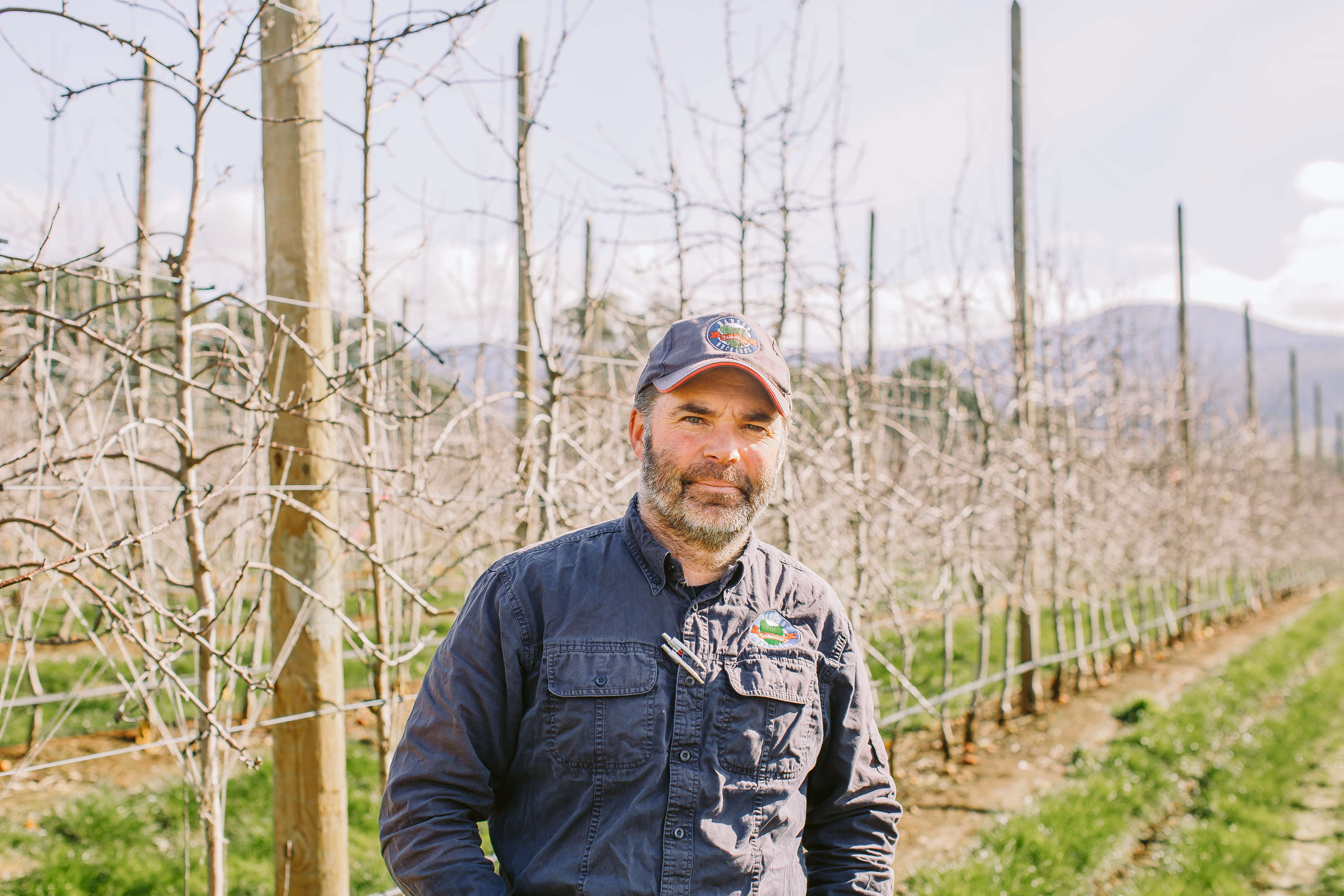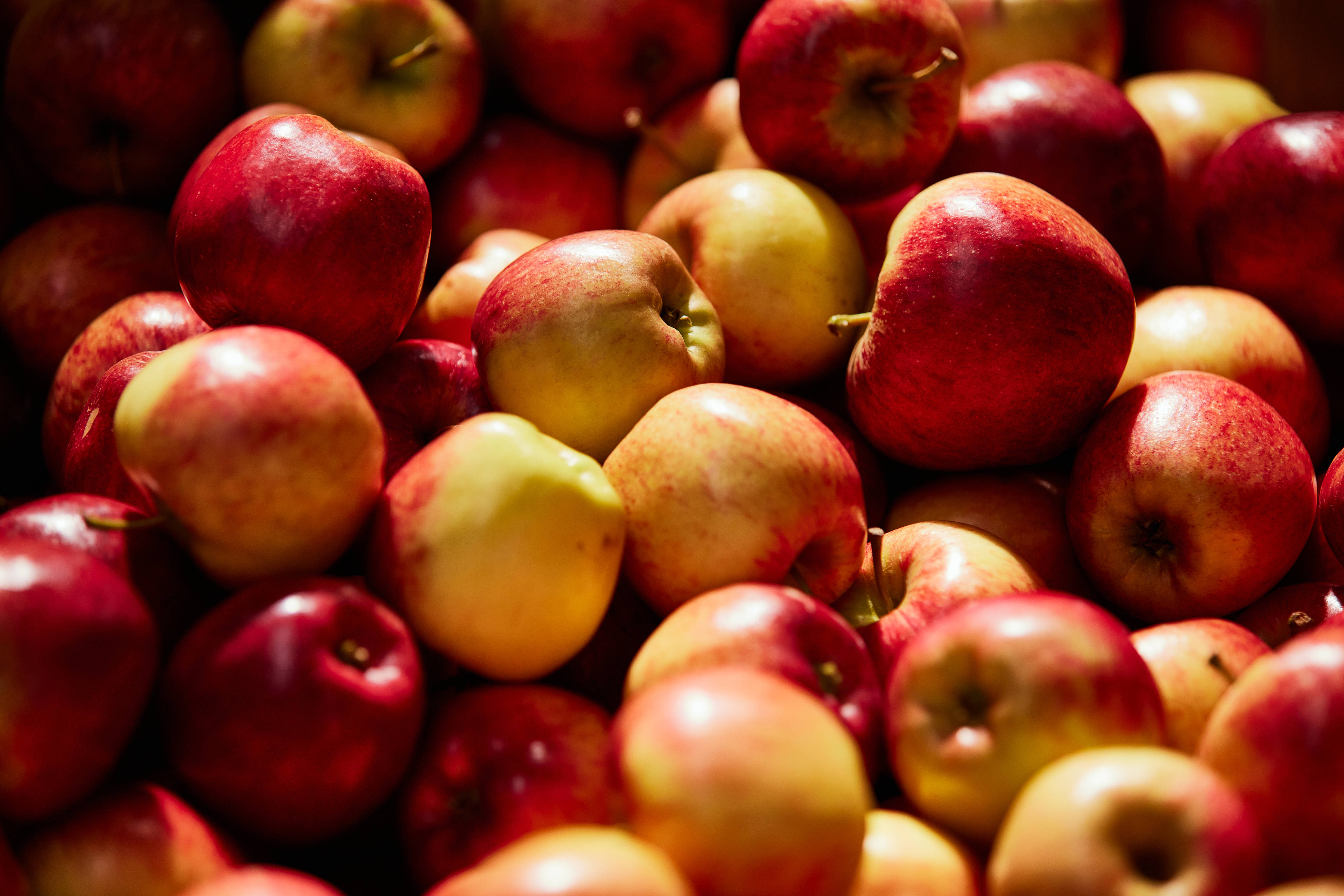There’s no one secret to the family’s success, rather a broad and methodical approach of trusting research, embracing technology and new varieties — in other words, a lot of eggs in a lot of baskets.
“There’s been no one silver bullet where things began to work for us, just lots of stuff that has made incremental improvements over time,” acknowledges the fourth-generation grower.
“I started here at end of 1994, and at that time our business was 70% Red Delicious, like most others in Tasmania, with the majority being exported to South-East Asia and India.
“I spent 1993 working in Hawkes Bay, New Zealand, and saw growers receiving as little as $8 per carton for 21kg cartons of Red Delicious from the New Zealand Apple and Pear Marketing Board.
“I thought as soon as we are only getting $8 a carton for Red Delicious, we are not going to be in business for very long.
“We needed to change our varietal structure, as we were finding it difficult to compete.”
With Red Delicious’ value at that time coming predominantly from the export market, and with increasing overseas competition, Howard recognised the need to diversify his family orchard’s approach.
“The strategy in the first instance was to be less reliant on Red Delicious and exports,” he said. “Royal Gala and Pink Lady were available, so we started growing them.
“Our focus was getting out of the low-density plantings that were labour-intensive.
“We started planting our own nursery trees in 1994. New planting on more dwarfing rootstocks of M9 and M26 allowed for a lot higher density. At that stage we had been 5m between rows, and we came in to 3.5m rows.
“We reduced the tree spacing to 1.5m and then to 1m.”
It is important to examine the early stages of Howard’s time at Hansen Orchards, because it shows the trust in available research and willingness to experiment that has characterised his work through to today.
A willingness to innovate and stay ahead of the curve are certainly common traits in successful apple and pear growers, and Howard has both of these in spades.
As well as being a pioneer of high-density plantings and club varieties in Australia, he has also led research and development by hosting Future Orchard trials on his own blocks, and testing the latest in production science and technology to improve fruit quality, harvest quantity, and production efficiency.
Continuing to innovate
The commitment to making changes in the mid-1990s worked and, together with father Carl and the rest of the Hansen Orchards team, Howard has continued to develop new methods based on research, and continued to reap the benefits.
Most recently, progressively higher-density plantings have been combined with a multi-leader V-trellis system, with those same old aims from 25 years ago of being labour efficient and maximising light interception.
“The last 25 years our apples have been a slender spindle, and historically we were about 2800–3100 trees a hectare,” he explains.
“The last four or five years we’ve come a lot closer, probably about 3571 per hectare. In the last two winters most of our plantings have gone on a multi-leader V.
“We’ve tried to go towards a tree that doesn’t have any branches but has four leaders, two up each side of a V.
“We think that’ll improve our light interception over the course of a season and make for a far simpler canopy, but it will also give us the potential to embrace mechanisation in the future.
“A three-dimensional tree is quite a complicated thing, it takes years to properly teach someone all the skills required to competently prune and trim new orchards.
“So, we go for two narrow canopies in a V, and that way we think we’ve got the best yield potential but still a relatively simple system that’s very, very easy to train people to operate on.”
As well as new growing systems, Howard is also happy to put his faith in technology where appropriate.
It is two degrees when I ring Howard, and in the days following, it will snow in the Huon Valley, a reminder that the famed ‘apple isle’ still serves up its share of climatic factors for growers to contend with.
After seeing the success of using rain covers over cherries in the region, Hansen Orchards decided to shift in the same direction for apples, by investing in hail-net and frost fans.
“They are two of the biggest climate issues we face, and it worked with the cherries, so we went in the same direction,” he says.
“We’ve also worked closely with a company called Ellips for grading technology and have recently updated both internal and external quality cameras and changed to high intensity LED lights to try and have a bit more accuracy on bruising and stem punches.
“Ahead of the 2020 harvest season we’ve invested in a couple of self-propelled platforms to assist with the labour efficiency, pruning, thinning and harvest.”
A strong pedigree
Howard’s pathway to Managing Director at Hansen Orchards followed a reasonably traditional route taken by Australian growers — grow up on the family farm, study at ag college and then return home and implement learnings to improve the family business.
“When I was younger, I loved growing up on the farm but was keen to do something more mechanically oriented,” Howard said.
“But then when I did that first year on the orchard, I never wanted to do anything else, and here I am.
“Studying at Marcus Oldham and the year in New Zealand were pretty important, I learnt a lot and made a lot of useful contacts and friends.”
Howard’s great grandfather Carl Hansen began growing apples in Tasmania in the 1890s at Nubeena, not far from Port Arthur, on the Tasman Peninsula. In 1944, Howard’s grandfather Rupert relocated his family to the Huon Valley with the purchase of an existing apple orchard at Grove, where they remain today.
It’s a decent size operation these days: along with 85ha of apple orchards that grow Envy, Jazz, Eve, Rockit, Ambrosia, Royal Gala, Pink Lady, Granny Smith, Fuji and Golden Delicious. They store and pack for 12 other growers in the region, and a slick, high-end cider label has come on in leaps and bounds to add value to their waste stream.
There are 135ha of cherry orchards as well, which have proved a highly profitable export commodity, although Howard says growing apples remains his “bread and butter”. Around 450 people are employed in the peak of cherry season.
Tasmanian through and through
Well documented is Hansen’s investment in tech, innovation and research, but the last few years has seen considerable investment in its community as well.
One example of this is the ‘Apples for Tassie Kids’ campaign from 2018–2019, where Hansen Orchards aimed to give a free apple to every kid in the state.
As Hansen Orchards Marketing Manager Baden Ribbon says, the idea stemmed from improving the health of Tasmanian kids, but there were benefits for Hansen and the entire industry as well.
“We know that the single best promotion is to put a good apple in someone’s mouth,” he says.
“We were alarmed by some of the health statistics that came from the Tasmanian Liberal Party’s 5 Year Strategic Health Plan.
“One third of Tasmanians aged 2 to 17 are considered overweight or obese.
“So, we decided to give a good eating apple to every single student in Tasmania with the belief that they would enjoy it enough to choose an apple as a healthy snack alternative going forward.
“In the end we gave over 150,000 apples away.”
Labour and other challenges on the radar
COVID-19 has ensured the issue of workforce availability is ever present on most growers’ minds, and Howard says he’ll be “watching very closely” moves made by the Government in this space between now and harvest.
“About 80% of our total payroll is paid to Tasmanians,” he says.
“There’s a smaller reliance on those working holiday makers, but that said, like everyone else we’re very interested in what the Government will do.
“A business like ours is reliant on having a team of good people to run it, and at the moment we feel blessed with the combination of experienced mentors and good keen passionate young guys.
“All businesses probably need a combination of both and we certainly feel like we’ve got that.
“The biggest challenge we all face as an industry is consistently delivering a good enough eating experience that the consumer wants to keep coming back.
“Consumption has been declining in Australia for a long period of time and we need to reverse that trend.”
Article republished with the permission of Apple & Pear Australia Ltd. This article was first published in AFG — Spring 2020.

